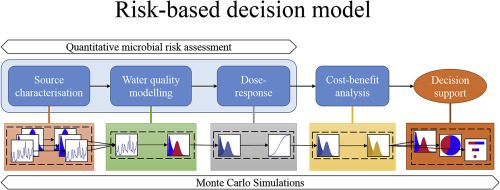Water Research ( IF 11.4 ) Pub Date : 2017-12-27 , DOI: 10.1016/j.watres.2017.12.054 Viktor Bergion , Andreas Lindhe , Ekaterina Sokolova , Lars Rosén

|
Waterborne outbreaks of gastrointestinal diseases can cause large costs to society. Risk management needs to be holistic and transparent in order to reduce these risks in an effective manner. Microbial risk mitigation measures in a drinking water system were investigated using a novel approach combining probabilistic risk assessment and cost-benefit analysis. Lake Vomb in Sweden was used to exemplify and illustrate the risk-based decision model. Four mitigation alternatives were compared, where the first three alternatives, A1-A3, represented connecting 25, 50 and 75%, respectively, of on-site wastewater treatment systems in the catchment to the municipal wastewater treatment plant. The fourth alternative, A4, represented installing a UV-disinfection unit in the drinking water treatment plant. Quantitative microbial risk assessment was used to estimate the positive health effects in terms of quality adjusted life years (QALYs), resulting from the four mitigation alternatives. The health benefits were monetised using a unit cost per QALY. For each mitigation alternative, the net present value of health and environmental benefits and investment, maintenance and running costs was calculated. The results showed that only A4 can reduce the risk (probability of infection) below the World Health Organization guidelines of 10−4 infections per person per year (looking at the 95th percentile). Furthermore, all alternatives resulted in a negative net present value. However, the net present value would be positive (looking at the 50th percentile using a 1% discount rate) if non-monetised benefits (e.g. increased property value divided evenly over the studied time horizon and reduced microbial risks posed to animals), estimated at 800–1200 SEK (€100–150) per connected on-site wastewater treatment system per year, were included. This risk-based decision model creates a robust and transparent decision support tool. It is flexible enough to be tailored and applied to local settings of drinking water systems. The model provides a clear and holistic structure for decisions related to microbial risk mitigation. To improve the decision model, we suggest to further develop the valuation and monetisation of health effects and to refine the propagation of uncertainties and variabilities between the included methods.
中文翻译:

基于风险的成本效益分析,用于评估饮用水系统中的微生物风险缓解
胃肠道疾病的水源性暴发会给社会造成巨大损失。风险管理必须是整体且透明的,以便有效地减少这些风险。使用一种结合概率风险评估和成本效益分析的新方法,研究了饮用水系统中的微生物风险缓解措施。瑞典的Vomb湖被用来举例说明和说明基于风险的决策模型。比较了四个缓解方案,其中前三个方案A1-A3分别代表流域内现场废水处理系统的25%,50%和75%连接到市政废水处理厂。第四个替代方案A4代表在饮用水处理厂中安装紫外线消毒装置。量化的微生物风险评估用于评估质量的调整生命年(QALYs)对健康的积极影响,这是由四种缓解措施引起的。使用每个QALY的单位成本将健康收益货币化。对于每种缓解措施,都计算了健康和环境效益以及投资,维护和运行成本的净现值。结果表明,只有A4可以降低低于世界卫生组织10准则的风险(感染的可能性)计算了维护和运行成本。结果表明,只有A4可以降低低于世界卫生组织10准则的风险(感染的可能性)计算了维护和运行成本。结果表明,只有A4可以降低低于世界卫生组织10准则的风险(感染的可能性)每人每年−4感染(占第95个百分位)。此外,所有替代方案均导致净现值为负。然而,净现值将是正的(看50个如果非货币化收益(例如,财产价值增加在研究的时间范围内平均分配,并且降低了对动物造成的微生物风险),则估计为每百分位数800-1200瑞典克朗(100-150欧元),即使用1%的折现率得出的百分比包括每年的现场废水处理系统。这种基于风险的决策模型可创建强大且透明的决策支持工具。它具有足够的灵活性,可以量身定制并应用于饮用水系统的本地设置。该模型为与降低微生物风险相关的决策提供了清晰,整体的结构。为了改善决策模型,我们建议进一步发展健康影响的评估和货币化,并完善所包含方法之间不确定性和变异性的传播。









































 京公网安备 11010802027423号
京公网安备 11010802027423号